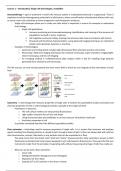Class notes
Immunotherapy and Immune Monitoring Lecture Notes - MSc Biomedical Sciences
- Course
- Institution
These are my lecture notes except the pre recorded lecture about Monitoring by multiplexed IHC! Hope it helps. Goodluck with studying :)
[Show more]



